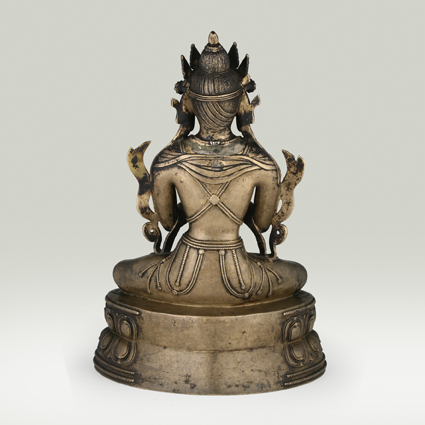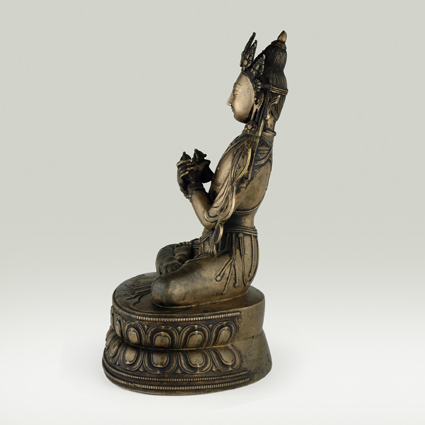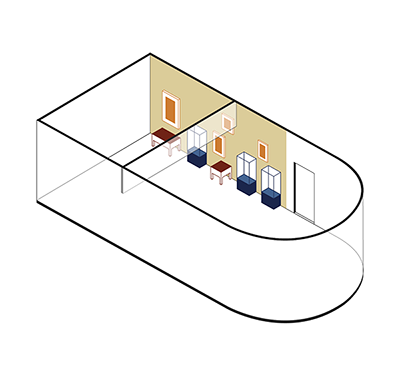ABS 221
Code: ABS 221
Country: Tibet (west)
Style: Tabo
Date: 1450 - 1550
Dimensions in cm WxHxD: 20.8 x 30.5 x 15.2
Materials: Brass
Adibuddha or primordial Buddha Vajradhara
Vajradhara is seated in the diamond attitude (vajraparyankasana) on a double lotus pedestal. With his right hand he holds a five-pronged diamond sceptre (vajra) at heart level, and he rings a prayer-bell (ghanta) with the left hand. The vajra symbolizes the male principle of compassion, and the ghanta the female principle of wisdom. Together, they represent the “skillful means” on the path to enlightenment.
Vajradhara is clad with a cloth (dhoti) tied around his waist with a belt. He wears princely ornaments, namely a small three-pointed crown in front of the tall knot of hair (jatamukuta), earrings, necklaces, ornaments at the upper arms, wrists and ankles, and the “investiture with sacred thread” (upavita).
Vajradhara practices are common to all of the four schools of Tibetan Buddhism and are used to clarify the confused mind. According to the “old translation tradition” (ngagyur) of the Nyingma order, the “Primordial Buddha” is called Samantabhadra. The “new translation traditions” (sarmapa) of the Kagyü, Sakya and Gelug orders call him Vajradhara or Vajrasattva.
The Adibuddha (primordial Buddha), whether he be named Vajradhara, Vajrasattva or Samanthabhara, can be depicted in union (yab-yum) with his consort named Prajna / Samantabhadri. Because the Adibuddha is seen as the source of the Five Wisdom Buddhas (Akshobya, Ratnasambhava, Amithaba, Amoghasiddi, Vairochana), it follows that Prajna / Samantabhadri is considered to be the mother of them.
Vajradhara is seated in the diamond attitude (vajraparyankasana) on a double lotus pedestal. With his right hand he holds a five-pronged diamond sceptre (vajra) at heart level, and he rings a prayer-bell (ghanta) with the left hand. The vajra symbolizes the male principle of compassion, and the ghanta the female principle of wisdom. Together, they represent the “skillful means” on the path to enlightenment.
Vajradhara is clad with a cloth (dhoti) tied around his waist with a belt. He wears princely ornaments, namely a small three-pointed crown in front of the tall knot of hair (jatamukuta), earrings, necklaces, ornaments at the upper arms, wrists and ankles, and the “investiture with sacred thread” (upavita).
Vajradhara practices are common to all of the four schools of Tibetan Buddhism and are used to clarify the confused mind. According to the “old translation tradition” (ngagyur) of the Nyingma order, the “Primordial Buddha” is called Samantabhadra. The “new translation traditions” (sarmapa) of the Kagyü, Sakya and Gelug orders call him Vajradhara or Vajrasattva.
The Adibuddha (primordial Buddha), whether he be named Vajradhara, Vajrasattva or Samanthabhara, can be depicted in union (yab-yum) with his consort named Prajna / Samantabhadri. Because the Adibuddha is seen as the source of the Five Wisdom Buddhas (Akshobya, Ratnasambhava, Amithaba, Amoghasiddi, Vairochana), it follows that Prajna / Samantabhadri is considered to be the mother of them.






